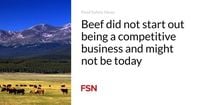Early Monday morning, the U.S. cattle and grain markets stirred with a fresh round of uncertainty and anticipation. Futures for cattle opened mostly lower, while hogs trended downward and grains—especially soybeans—snapped back into rally mode. But beneath these numbers lies a deeper story of trade policy, antitrust drama, and the ever-evolving struggle between American ranchers, giant meatpacking companies, and the federal government.
The week began with the Trump administration announcing a reduction in tariffs on 200 food items, including beef from Brazil and Argentina. According to Cattle Digest, the 50% tariff on Brazilian beef was trimmed by 10%. Although the move initially pushed cattle futures lower, the market soon steadied. As Brad Kooima of Kooima Kooima Varilek explained, "the fear of Brazilian beef tariffs being lowered was part of the selloff in the cattle futures last week and why the market started off lower." However, with some clarity restored, uncertainty faded and futures stabilized.
Brazil’s significance in this equation can’t be overstated. As the top importer of beef trim blended into ground beef, any shift in Brazilian beef imports can send ripples through the entire U.S. beef market. But the policy change was less drastic than feared, and the market’s reaction was muted compared to earlier volatility.
Yet, one big question remains: when will the Mexican border reopen to feeder cattle imports? USDA Secretary Brooke Rollins stated last week that there is "no date for reopening the border" but acknowledged ongoing efforts to establish a protocol. President Trump, for his part, is reportedly "anxious to resume trade." The colder weather, Kooima noted, is expected to slow the spread of a parasite that had contributed to the border closure, raising hopes that policy changes might come sooner rather than later.
Despite a lower weekly close in live cattle futures, the market found some technical footing. The February live cattle contract tested and held the $215 support level it had broken out from in July. January feeder cattle futures closed slightly higher for the week, holding at $310 support after dipping to $310.05 on Friday. Still, Kooima cautioned that "double bottoms seldom hold in the cattle market," leaving some uncertainty about whether these technical supports will last.
On the ground, producers faced tough news. Last week, cash fed cattle prices in the South dropped to $228, down $3, while the North saw dressed volume prices fall to $351, down $8. Live sale prices started at $226 early in the week but slipped to $222 by Friday. Kooima expects lower trade again this week. And with producers feeding cattle longer, weights are starting to creep up. Packers, seizing the opportunity of improved margins, increased slaughter for the week to 576,000 head—up 16,000 from the previous week.
All this comes amid renewed scrutiny of the meatpacking industry’s power. Over the weekend, President Trump doubled down on his call for the Department of Justice to investigate the so-called "Big Four" meatpacking conglomerates—Tyson Foods, Cargill, National Beef, and JBS USA. According to Bloomberg, Trump accused these "foreign-owned meatpacking cartels" of price fixing, collusion, and market manipulation, declaring, "Action must be taken immediately to protect consumers, combat Illegal monopolies, and ensure these corporations are not criminally profiting at the expense of the American people."
This isn’t the first time such accusations have been leveled. In fact, the U.S. beef industry has a long and tangled history with monopoly power. As Food Safety News recounted, the late 1800s saw the rise of the "Beef Trust," a cartel of six companies—Swift, Armour, Morris, Cudahy, Wilson, and Schwerdter—that dominated the meatpacking industry. President Theodore Roosevelt famously took on these monopolies, leading to the landmark Supreme Court case Swift & Co. v. United States in 1905. The ruling empowered Congress to regulate monopolies under the Commerce Clause, and Roosevelt’s administration cracked down on antitrust violations, including price-fixing and collusion.
Fast-forward to today, and the landscape looks eerily familiar. The "Big Four" now control up to 85% of the U.S. beef market, according to industry experts. R-CALF USA CEO Bill Bullard, who heads the nation’s largest cattle association exclusively representing farmers and ranchers, has long pushed for government intervention. In his latest commentary, Bullard wrote, "There have been complaints about the monopoly control over the United States’ beef supply chain for decades, with no meaningful government enforcement of our U.S. antitrust laws or the Packers and Stockyards Act." He recalled a partial victory in 2009, when the Department of Justice forced JBS, a Brazilian-owned company, to withdraw its proposed acquisition of National Beef Packing Co. after antitrust enforcement action. But, as Bullard lamented, "Although the Justice Department’s action slowed the formation of our monopolized beef supply chain, it didn’t stop it, and our industry continued to shrink. In contrast, monopoly-structured cattle and beef markets persisted."
Now, the cycle repeats. Trump’s latest intervention is seen as a response to years of inaction, with cattle prices falling while consumer beef prices hit new highs. Whether this new investigation will have more bite than previous efforts remains to be seen. Kooima, for one, is skeptical, citing the lack of results from past probes during COVID-19 and after the Holcomb, Kansas plant fire.
Meanwhile, the rest of the livestock complex is in flux. Lean hog futures have been volatile, with the Lean Hog Index falling another $0.89 to $87.89. The cash market for hogs continues to slide, and there’s little sign of stabilization just yet.
On the grain side, the market has resumed its rally, led by soybeans. President Trump announced he would personally talk to China about buying U.S. soybeans, giving the market a jolt even though only 12.2 million bushels were reported in the flash export sales backlog last Friday. However, the USDA issued a correction to their cumulative daily export sales announcement on November 17, 2025. The correction confirmed a cancellation of 100,000 metric tons of soybean sales to China originally reported on November 3, 2025, and removed an erroneous corn sale of 130,000 metric tons to Japan dated October 24, 2025. The corrected sales volumes will be reflected in the Weekly Export Sales report released on December 11, 2025.
For now, America’s cattle and grain markets remain caught between the push and pull of global trade, domestic policy, and the shadow of corporate concentration. While history offers some hope that government action can rein in monopolies, the lessons of the past remind us that progress is rarely quick or straightforward. Ranchers, traders, and consumers alike will be watching closely as the story unfolds.




